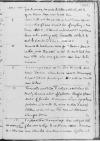Letter #5769
Alfonso de VALDÉS to Ioannes DANTISCUS[Regensburg], [ca. 1532-04-16 ?]
English register:
Valdés didn’t reply sooner because he was very busy, and didn’t have any news for Dantiscus, either. He reproaches him for his impatience and suspiciousness. He explains that his business have been delayed due to the emperor’s illness; the emperor was forced to neglect even his own affairs. He assures Dantiscus of his friendly feelings. He likes the portrait (simulacrum), therefore he will send another so that Dantiscus can have it corrected to look like the first one. He passes on master Granvelle’s request that Dantiscus send the painter to him tomorrow at five in the morning.
Manuscript sources:
Auxiliary sources:
Prints:
| ||||||||||||||||
Text & apparatus & commentaryPlain textText & commentaryText & apparatus
Salutem.
cf.
Simulacrum placet et aliud ad te mittam, ut ad eum modum corrigi facias.[1] Dominus
Vale.
Tuus
[1] Simulacrum mentioned here could be a medal, as they were produced in many copies, which were cast in metal and then often manually reworked by the medallist. In 1529-1532 both Dantiscus and Valdés were portrayed by a German medallist and sculptor
